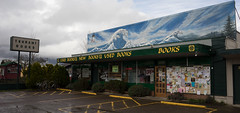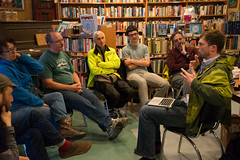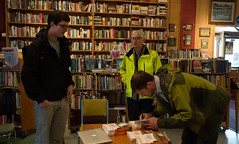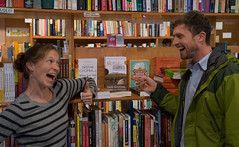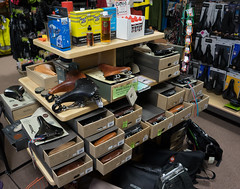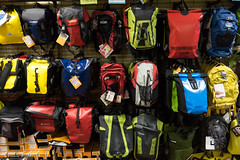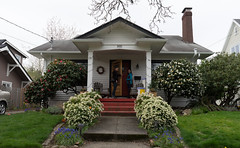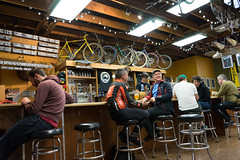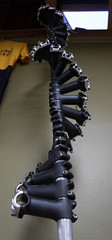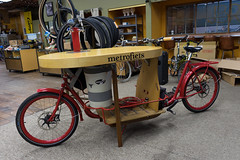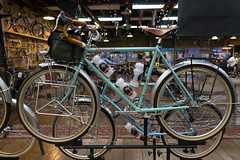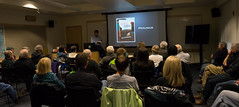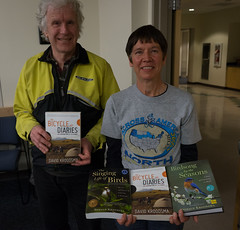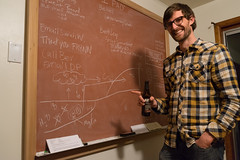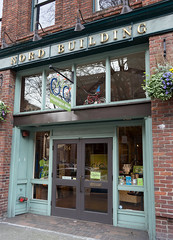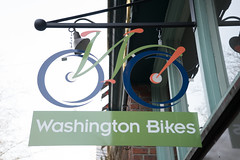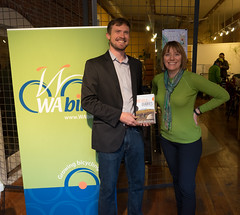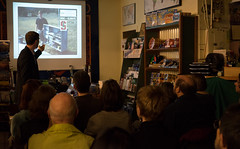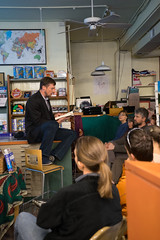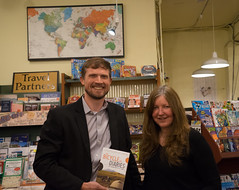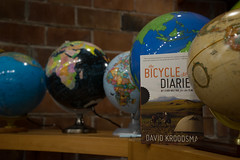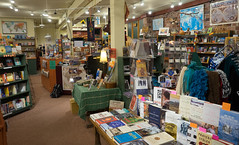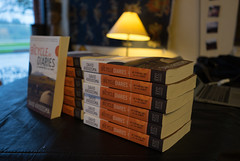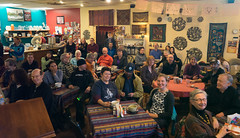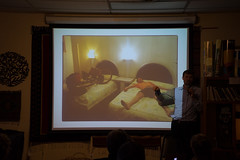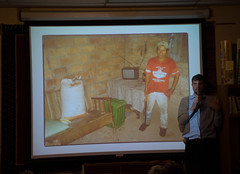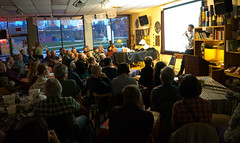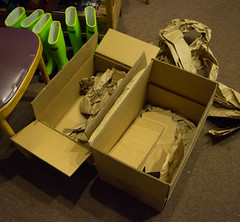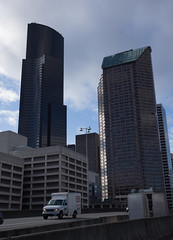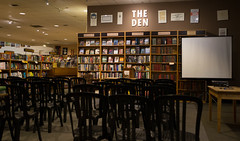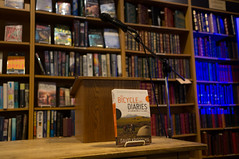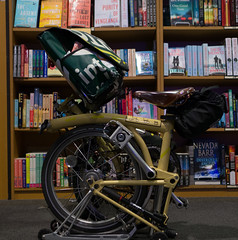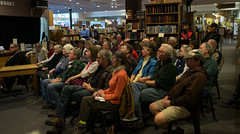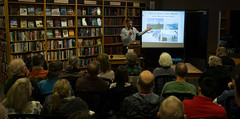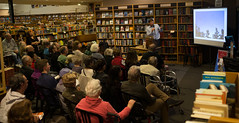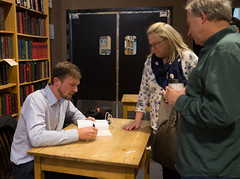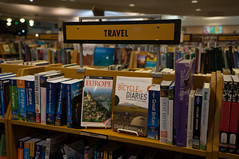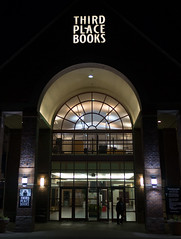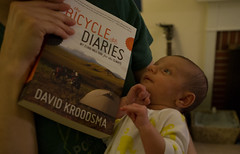The following is from an Appendix in my book, The Bicycle Diaries: My 21,000-Mile Ride for the Climate. For the next week, you can pre-order a copy on Kickstarter here.
—-
APPENDIX II: General Recommendations on Bike Touring
I can’t tell you how you should bike tour, because there is no right way—there are advantages to each approach. Some people tow trailers, some have panniers. Some people travel so light they saw off their toothbrushes; others would strap a guitar to their rear pannier and carry a dog in a trailer. Some like to stay at hotels, some like to camp. Some trips are planned to the day; others ride as it comes. But gear and planning count less than attitude. As one cycle tourist I met said, “all that matters is if you have a smile on your face.” (Incidentally, he rose at sunrise, biked until 3 PM, then spent a few hours at the neighborhood bar.) In short, take any bike-tour advice you receive with a grain of salt. The only way to figure out what works for you is to try it out.
Since my first bike tour in 1999, I’ve logged just shy of 30,000 miles of “loaded” bike touring—touring where I’ve carried my camping gear. That includes the 21,000 miles of this trip plus a week-long trip in Alaska, a trip down the Pacific Coast, a month-long ride in Eastern Europe, and a trip across the U.S. with my dad after graduating from my master’s program—not to mention numerous weekend excursions. With all this pedaling, I’ve learned what details make for the perfect bike trip—for me.
THE BIKE
On longer, international trips, durability is more important than speed, since the bike breaking down in a remote area could set your journey back a week or more. On longer trips I prefer a steel touring bike. Though steel is heavy, it is less prone to damage and can be fixed via welding. I like twenty-six-inch mountain bike wheels, as they are more commonly found throughout the world than the slightly larger road bike wheels—which is important when you need a spare tire. For the same reason I make sure the bike’s rims can take the more common Shrader valves. (If your bike is set up for Presta valves, you can have a bike shop enlarge the hole.)
On shorter trips closer to home, you can get away with a lighter bike. But on any touring bike it is very important to have a strong rear wheel, preferably with thirty-six spokes. If you have panniers, this is where most of your weight will be. Note that replacing a broken spoke on the rear wheel is an enormous pain. (Always carry extra spokes!)
It is extremely important that the bike have low-enough gearing—you’ll want all the help you can get when climbing up a steep hill with weight. My smallest chain ring in the front has twenty-two teeth, and the largest in the rear has thirty-four, which is about the lowest gearing you can get.
I also recommend a high-quality pannier rack, preferably made of steel. I’ve seen many cheap aluminum racks break.
The most important feature of a bike, though, is comfort—nothing matters more. Nearly every cyclist I know has a different preference for a saddle, although the most popular among long-distance cyclists are expensive leather saddles, such as those made by Brooks. I used a nose-less saddle (a Hobson Easyseat), which was easier on my rear but put more weight on my hands. To compensate, I prefer to ride as upright as possible, as such is easier on the neck and hands.
PANNIERS VERSUS TRAILER
When traveling light, the best system is one or two panniers—or, better yet, a SINGLE stuff sack on a rear rack, which is lighter and more aerodynamic. When carrying larger loads, you can use either four panniers or a trailer. At first consideration one might think the trailer would add more weight, but sometimes it’s only slightly heavier—given the weight of the racks and panniers, and the fact that the bike needs to be stronger to carry more weight. And while a trailer does add some rolling resistance, air resistance is usually more important, and one-wheeled trailers are generally more aerodynamic than four panniers. On my trip, though, I chose to use four panniers because it made the bike easier to carry upstairs and bring into hotel rooms or stores. Also, it fit more easily into pickup trucks, boats, and planes.
GEAR IN GENERAL
The heavier the gear you carry, the heavier your bike has to be. If you want to carry fifty pounds of gear, you will need a bike with extra-strong wheels and a strong rear rack—which means that the bike will have to be stronger and thus heavier to support this weight. Also, the heavier your bike is, the beefier your tires have to be, and the more rolling resistance you will have. Less is more.
STOVE
I usually use an alcohol-burning stove, which I made from two aluminum soda cans. (An Internet search for “alcohol can stove” will generate plenty of guidelines.) It weighs almost nothing. Also, having alcohol on hand is great for killing germs and disinfecting cuts. The only challenge is finding the right alcohol: make sure it is more than 90 percent pure, preferably more than 95 percent. I had the most luck at hardware stores and pharmacies, especially in Latin America—less so in Eastern Europe. Note that these stoves don’t always work in cold weather or at higher altitudes, so they wouldn’t be the best choice for some trips.
SLEEPING BAG & PAD
A high-quality down sleeping bag can compress to almost nothing. Do take care to not get the bag wet, though this is usually only a challenge in exceptionally wet climates. I like using a thin three-quarter length inflatable pad underneath. Be sure to bring a patch kit if you opt for something inflatable.
TENT
Choosing your tent wisely can save a lot of weight. I strongly recommend Tarptents (www.tarptent.com), as they are single-walled and well-ventilated. My two-pound Tarptent Rainbow had enough room for me and all of my gear, was sufficiently ventilated for hot nights in the tropics, and kept out heavy rainstorms. I did have to reseal the seams halfway through my journey, but I probably would have had to do that with any tent.
WATER BLADDER
I carry a six- to ten-liter water bladder (I prefer MSR Dromedary bags). I like the independence of not needing to rely on a faucet or stream near my campsite, so a ten-liter bladder is one of my most useful camping items, as it can provide water for dinner and breakfast. I generally fill it around 20 to 30 minutes before looking for a campsite.
EXPANDABLE STUFF SACK
I like to carry an extra waterproof stuff sack; this comes in very handy if I need to ride for a few days without resupplying. I reserve the space atop my rear rack for those occasional extra items.
TOOLS
I generally carry the basic set of tools: Allen wrenches, small crescent wrench, chain tool, extra chain links, patch kit, spoke wrench, and three extra spokes. I also always carry zip ties, duct tape, and extra bolts, just in case. But note: the tools are less important than the mechanic. The best advice is to get lots of experience fixing bikes. Inevitably, though, something will break that you won’t be able to fix; at those times you’ll have to either rig up something or hitchhike. Be prepared for either scenario.
CLOTHES
In addition to one or two sets of street clothes, I usually carry two pairs of biking shorts and two jerseys. My arm and leg warmers are incredibly useful, and take up little space. I often travel with rain jackets and rain pants that are merely water-resistant rather than waterproof, mostly because these pack down smaller than their GORE-TEX equivalents do. But also, when it rains my goal is not to stay dry, but to stay warm. In that vein, synthetics are much better than cotton—they dry more quickly and keep you warmer when wet.
SHOES
If you use clip-in pedals, make sure you can walk comfortably in them. I prefer to use bike sandals (Shimano makes sandals that can take cleats), so I don’t have to wash socks as frequently. (I wear socks and rain covers over my feet in colder or rainier climates.) For much of Latin America I traveled with Chaco sandals and flat pedals; it was great having a single pair of shoes.
PANNIERS
I much prefer waterproof panniers over non-waterproof, as I dislike having to put on a rain cover every time clouds threaten rain. On my trip, though, I had two waterproof panniers and two non-waterproof ones. One advantage to the non-waterproof pannier is it has better air circulation; this was great for storing wet items like my still-damp cooking pot. In addition to the panniers, I also like a handlebar bag, which is a handy stash for a camera and snacks.
FOOD
One of the hardest things to learn is how to eat enough food. Many people don’t eat enough on their first tours and spend hours grumpy and frustrated, unaware they’re suffering from low blood sugar. So, my advice: eat early and often. Essentially, eat before you’re hungry, and don’t go for more than two hours without eating something. Each person, of course, is different, and you’ll have to find your own eating strategy. Just be sure to consider it a strategy—you burn a lot of calories while riding.
CAMPING
Obviously, learn what the rules are about “free” camping in the places you travel (although, to be honest, I’ve often not done this). I try to make sure no one sees me when I leave the road to camp, and then I pitch the tent where it is unlikely to be found. Also, be smart. While you might be less safe camping as an individual than with group, you’re also less likely to be found.
If you’re traveling in a country where you don’t speak the language, at least learn how to say “tent, one night” in that region’s tongue. That phrase, plus some sign language, are usually all I need to easily find an overnight spot. And, when asking to camp behind someone’s house, be sure you have all the food and water you need—it’s best not to ask for anything more than a spot for the night.
Of course, many people will invite you into their homes.
STAYING AT PEOPLE’S HOMES
People are often extremely generous in opening their home to a stranger, perhaps because they’re both envious of your adventure and sympathetic to your exhaustion. For the most part don’t be shy about accepting what you’re offered—few hosts grant their hospitality reluctantly, and in some situations or cultures a refusal might be seen as rude. So, be ready to share stories of your travels in return. And be a good houseguest. This means always being self-sufficient, supplying your own food and water. Also, don’t overstay your welcome. I always try to leave on a high note—while my host is still enjoying the visit. I am especially careful if I have to stay anywhere longer than two nights. And be sure to get the person’s address to send a thank-you note at trip’s end.
FIRE STATIONS
Throughout Latin America, many fire stations MAY offer an empty bunk for the night. I imagine that someday liability concerns will put an end to this generosity—the reason this plan doesn’t often work in the U.S. Of course, offer your hosting fire station the same courtesy you would when staying at someone’s home.
***
When Bill Bradlee was deciding whether or not to join me biking across the U.S., someone told him: “If you want to hate this country, read the newspaper every day. If you want to love this country, ride a bicycle across it.” Nothing could be truer. The news depicts the world as a scary place—filled with crime, disasters, and other perils. The world you experience from a bike, though, the “real world,” is very different, and it is absolutely amazing—full of smiling, generous people who care about the place they call home.
So, take the time to travel. Get on a bike, get out there, and explore the world at ten miles an hour. You will love it more, and it will give you hope.







